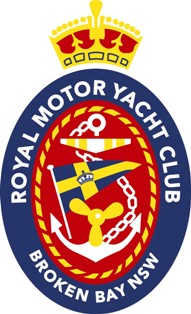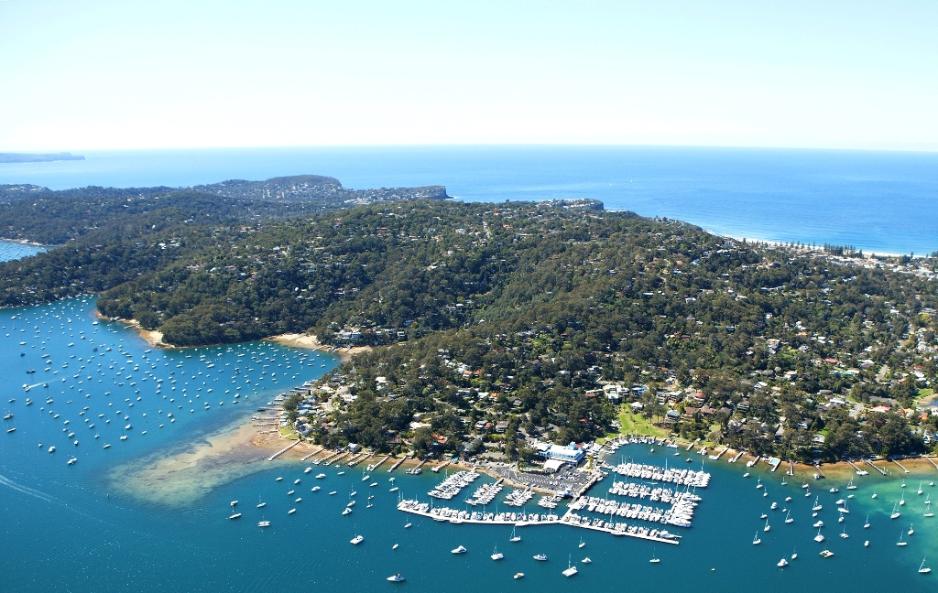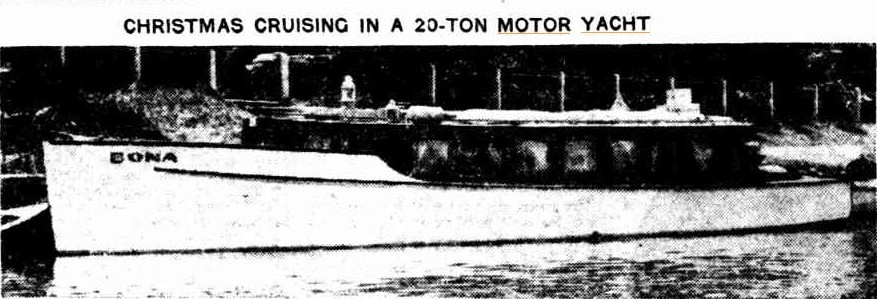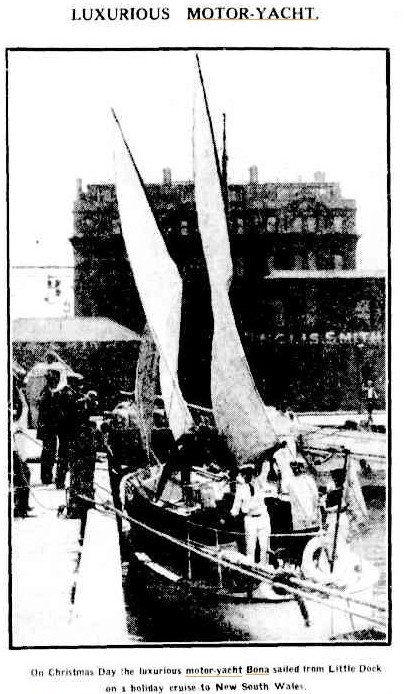March 9 - 15, 2014: Issue 153
A History of the oldest division in the Royal Motor Yacht Club
by Les Spencer
SOURCE OF INFORMATION
The Club has a collection of Annual Reports dating back to 1946, (following the end of the second World War 1939-45). These were donated by the family of a deceased member some years ago. Examination of these outlines the following history of the formation of the Cruiser Division.
 Each report has a
section called Racing Report, these show that many of the cruiser events back
then were Speed Events, or races and were mainly conducted with small boats.
This was obviously prior to the introduction of No Wash zones in Broken Bay.
There were events held between many other Yacht Clubs in NSW, Rose Bay, Port
Hacking etc. The 1946 report reports that our Club had lost the trophy for the
best NSW Cruiser, a trophy we had held since 1938, (not competed for during the
war).
Each report has a
section called Racing Report, these show that many of the cruiser events back
then were Speed Events, or races and were mainly conducted with small boats.
This was obviously prior to the introduction of No Wash zones in Broken Bay.
There were events held between many other Yacht Clubs in NSW, Rose Bay, Port
Hacking etc. The 1946 report reports that our Club had lost the trophy for the
best NSW Cruiser, a trophy we had held since 1938, (not competed for during the
war).So, the RMYC Cruisers were in active competition prior to 1938.
Port Hacking’s Prestigious Harry Peel Trophy, commenced in 1934 and our Club entered some of their early event.
The war intervened and competition was almost nil, an obvious shortage of boats, fuel and men. After the war the club recommenced activities and the cruisers were there in force. Some events in 1946/47 were well contested with 21 boats entered in several events.Very good considering the total CLUB membership at this time was just 143.
They were still doing Speed events as well as Cruiser Navigation events around this time under some format; essentially it appears these navigation events were run on a start and finish time calculated against each boat’s declared speed. There is no record of check points being used at this time.
A handicap system was introduced to give some advantage to the slower boats. It is noted some of the larger boats entered with speeds of 22 knots even back then!
FORMATION OF THE CRUISER DIVISION
Around 1947 the club had plotted a measured the distance between two visible shore based locations and issued the distance and the time calculations to complete this at various boat speeds. This allowed boats to use such as a measuring tool to check the accuracy of their boats instruments.
In typical Aussie fashion the boaties saw this as a way to have competitions against each other each other, just for fun, over a pre- selected course to see if they could maintain their average speed over the course and finish at the correct time relevant to their declared speed. They used only their boat compass and stop watch, GPS was not around then. They extended this by adding extra legs to the course and added more check points. The courses were always on Pittwater and always finished at the Club where they compared results over lunch.
They advanced this by introducing extra visible check points along the way, jetties etc , and each boat had to record their time as they passed these. To allay possible “cheating” they positioned an observer on each boat to record these times.
They officially became the Cruiser Competition Division, registered as such with the Club around 1950 and appointed their own Committee to run these events, separate to the RMYC Committee, but still under the regulation of the Club.
As Division progressed they added different courses for each event and introduced land based Check Pointers, persons, (usually a relative or friend), would be allocated a position on the shore adjacent to Pittwater. Check Pointers were provided with a sighting device which had to be placed in a set position and a stop watch, and received a packed lunch. They were given a list of competing boats, each of which carried a large number on the bow. They were also given information relating to the actual time each boat
was due to pass their particular check point. Check pointers would record the boat time and calculate the seconds, or minutes, each boat was early or late.
Check Pointers made their own way to land accessible locations at Taylors Point, Palm Beach, etc, and the division would ferry others to water access points, like Portuguese beach, Flint and Steel beach.
Check pointers were often “dunked” on landing at some of these. The hardy souls then had to complete their shift whilst drying off and being picked up again.
To prevent competitors from being only on time at the known check points, regardless of the course, the Committee did not announce which check points would be in use at each event. They would choose 7 or 8 from a known 15 locations. The skippers then had to be on time throughout the course not knowing where they would be checked.
More boats entered and the division progressed. They acquired sponsors and trophies for each event, plus a Champion Boat Points Score trophy and also a Navigator award. The Division then began competing against other Yacht Clubs. The Kuringai (Cottage Point) club had their own trophy, the AC WOOLL trophy. This was competed for once a year as a team event with the best 3 boats scores from either club deciding the winner.
The Port Hacking Yacht Club were also conducting competition events, their major event being the HARRY PEEL Trophy. This had been held since 1934, (interrupted by the war) and was initially speed contests but changed to navigation events later. Our Club began entering as a team, choosing our best 3 boats. This event began at Broken Bay and sometimes Rose Bay and always finished at Port Hacking.
Our Club was successful in both these inter club events on numerous occasions.
In 1997 the Division created its own ocean event, the BLUE WATER OCEAN CLASSIC. This was open to all yacht clubs and the course was set from our Club in Broken Bay, to Sydney Harbour and return to our Club, a distance of 42 nautical miles. This required 22 check points to be set up down the coast. Two persons per check point who had to stay for several hours to monitor boats to and from Sydney. Quite a logistical challenge.
The inaugural event had 23 boat entrants, from our Club. Port Hacking, Rose Bay, and Southport in Queensland, and one from the Coast Guards. The event was well sponsored with a first prize of $5,000. Presentations were made at our Club during a formal dinner. This event was run for five years with diminishing entrants and finally ceased due to lack of sufficient entrants.
The Division continued through the 1950’s, 60’s, 70’s, 80’s, 90’s and into year 2000 with a good record of entrants. Speed Races were long gone with No Wash and 4 knot zones in place on Broken Bay.
A handicap system remained in force during the 1970’s and was only lifted in the late 1990’s. The Committee then placed an 8 knot limit on boat entrants to replace the handicap.
The Division changed their time measuring procedures to eliminate land based check pointers. They trialled a GPS monitoring system with data loggers on each boat to record the boat time against random selected checkpoints undisclosed to the boat crew but GPS usage was still forbidden during the event.
After many box failures they persevered with these until newer, better, units became available. These are now in use on all events and have proved to be most reliable.
Insurance regulations required the Division to drop the word “race” from their events. They are now all known as “events”
The Committee dropped the word “competition” from their title and became, what they are today, the CRUISER DIVISION of the RMYC in the mid 2000’s.
CURRENT
The Cruiser Division continues today maintaining the same traditions as their forebears, using only stopwatch and compass to navigate, strictly NO GPS. These must be switched off. It is an honour system.
.In an average season six Navigation Declared Speed events are conducted with one of these being a Predicted Log event. In this all time pieces are prohibited, just use your compass and knowledge of your boat’s capabilities.
These are interspersed with social events on water, Paper Chases, Questionnaires, finding clues etc. Always ending with a Raft Up in a local bay with a BBQ and other refreshments.
Progressive Dinners on the water, moving from boat to boat, Fancy Dress days and Theme Days are also popular.
All the events are sponsored with impressive trophies and generous prizes for winners and place getters. Some of the trophies go back many years.
The division Handbook is produced each year with details of the calendar, committee contact details, club regulations for water sports, and rules of all the events. This is also sponsored with advertisers taking space.
A Presentation Night is held at the end of each season This is usually a Black Tie Dinner Dance, Mess Jacket or Formal wear for men, Cocktail dresses for the ladies, all trophies are presented and sponsors acknowledged.
Currently the division has 120 registered members, and one Life Member, (Les Spencer)
SOME FACTS
Cruiser Division Captains in recent years have been:
o David Rogers 2008 / Present
o Bob Nicholson 2001 / 2008
o Les Spencer 1999 / 2001
o John Barnett 1997 / 1999
o Barry Barnett 1995 / 1997
o Mike Pawson 1993 / 1995
o Brian Thomas 1991 / 1993
Major Sponsors over the years have been:
o Peter Haig
o George Bidder & Family
o Bob Frost
o Dick Chapman
o G Brothers Mona Vale
o Caltex
o Mark Lloyd
Major Trophies
o Boat of the year
o Navigator of the year
o Caprice
o Mee Tu
o Clae
o Cash Flow
o General Manager’s
ROYAL MOTOR YACHT CLUB BROKEN BAY NSW - CRUISER DIVISION HISTORY by Les Spencer, courtesy Royal Motor Yacht Club - Broken Bay, 2014.

As part of the 2014 Pittwater Festival, a Navigation Trial and Paper Chase form part of the events programme:
Blue Water Navigation Trial
Saturday 29th March 2014
8am to 11am
Royal Motor Yacht Club Broken Bay extends a hearty invitation to join in and be part of the Blue Water Navigation Trial on Saturday 29th March and the Pittwater Paper Chase on Sunday 30th March 2014. These events are part of the inaugural R-Marine Riley - Pittwater Festival.
The Blue Water Navigation Trial is limited to only 25 competitors, who may use all forms of navigation aids; including electronic chart plotters, radar, depth sounders, speed logs; as well as compass and time keeping instruments to complete the nominated course.
You are encouraged to involve as many of your family and friends as there is no limit to the number of crew you may have aboard. You will be provided with a topographical chart (provides more detail on land based objects for taking bearings) which includes the course clearly marked. Legs of the course for the main part, line up with land based prominent features to aid course navigation. In these instructions you have will also been provided with the waypoint latitude and longitude for the start, each turning point and the finish point. Also provided will be the approximate magnetic bearings and cumulative distance in nautical miles for each course leg. In other words you have all the information to enable you to steer an accurate course and to be on time along the course.
The maximum speed allowed to be declared for this event is 8 knots but please be aware of your wash when passing other boats and you must observe the Roads and Maritime rules for safe navigation at all times. The event which starts in Pittwater travels up to and into the entrance of the Hawkesbury River before returning to back to a finish in Pittwater.
The event will be scored using GPS tracker boxes to be placed on each boat. These boxes are to be promptly returned to the Event Committee at the RMYC immediately after completing the course to allow each boat’s score to be computed. For every second a boat is either early or late at secret check points along the course a penalty point will be incurred. The boat with the least penalty points will win the event and second and third will follow with the next least number of points etc. Great prizes will be awarded to the winning boat and those that run second and third.
Start times will be advised after receipt of all entries on Friday 21st March. The Course Chart and Instructions will be available for pick up after receipt of your entry form from RMYC Reception. Cathy McDonald 99975511. More Details here
Pittwater Paper Chase
Sunday 30th March 2014
12pm to 2pm
Come and join in the fun of the last event of the R-Marine Riley Pittwater Festival.
You are guaranteed a great afternoon on your boat and the beautiful waters of Pittwater. The Paper Chase is a challenge of observation, whereby you follow simple instructions that are provided when you enter, to navigate the course which starts at the Royal Motor Yacht Club Broken Bay and takes you to various locations around Pittwater. Along the way you will be asked to find the answers to questions that are provided on the questionnaire from things you will see on the way.
You will be asked to find, various locations, names, objects or identifying features on the shoreline or on the water along the course.
Clues might be, a particular house or jetty, a name on a boatshed, or unusual object that is nearby. The clues may be straight forward, or cryptic, or just plain tricky. Clues will be in the order of the key locations that you have to navigate to, so there is no need to back track.
The course takes you from the RMYC across to Scotland Island, then head North to Stokes Point, then to Morning Bay on the western foreshore, then head around Scotland Island towards Bayview and then to the finish off the RMYC. Questionnaires will be marked by completely incorruptible, dedicated, invisible officials of the RMYC!
Allow approximately TWO HOURS on the water to complete the questions.
You are required to be back at the RMYC by 2pm to hand in your completed questionnaire. Time then to relax enjoy some food, refreshments, live entertainment and the presentation of prizes.
Excellent prizes for the most accurate and other novelty prizes to be won. More Details here
Bona - the Cruiser:
also see - The Classic Yacht, The Bona
LAUNCH OF A MOTOR YACHT. CHRISTENED BY THE PREMIER. At the invitation of the Standard Oil Engine Company, there was a large gathering of gentlemen interested in aquatics yesterday, at the ship building yard of Mr. W. Holmes, M'Mahon's Point, North Sydney, on the occasion of the christening and launching of a beautiful motor yacht, designed and built by Mr. Holmes to the order of Mr. J. E. Chinnery. The craft, which is moulded on graceful lines, measures 50ft overall, with a beam of 10ft and a depth of 4ft 9in, and will draw 4ft of water. The engines are by the New York Standard Oil Engine Company, are of 25 horse-power, and will develop a speed of between 10 and 11knots.
The launching ceremony was performed by the State Premier (Mr. J. H. Carruthers) who, as the vessel left the ways, broke a bottle of champagne over her bows, and christened her "Bona" amidst the cheers of the large number of invited guests, and others attracted to the scene. The Bona, gaily decorated with bunting and with the flag of the P.A.Y.C. flying proudly, took the water like a swan. The party then adjourned to an adjoining shed, where an oyster luncheon was provided, and which was presided over by Mr. P. H. Sullivan, M.L.A. An appropriate toast list was gone through. LAUNCH OF A MOTOR YACHT. (1904, November 11). The Sydney Morning Herald(NSW : 1842 - 1954), p. 6. Retrieved from http://nla.gov.au/nla.news-article14648943

THE INCREASED EFFICIENCY AND SPEED OF OUR MOTOR BOATS
 READY FOR USE ON -THE TURN OF A HANDLE, and would propel a
loaded boat at a good speed to whatever point was desired; or take it for a
cruise all round the Harbor without a falter, no matter whether the wind blew or
did not. The contrivance was warmly welcomed, and it is no exaggeration to say
that hundreds of people who might never have set foot, in a sailing or rowing
boat were instantly attracted by its advantages. Boat builders experienced an
unprecedented demand. The industry took a fresh lease of life, and you can judge
from what you see in the yard here, that there is no immediate reason for
fearing that it will again decay. In fact; I think most of us would willingly
expand our works if we could find the necessary space. That is what the
motor-boat has done, and is still doing for us; the mosquito fleet you see
anchored in nearly every bay and cove in Sydney Harbor during week days, and
which on Saturdays, Sundays, and holidays, is so much in evidence cruising
about, or conveying picnic parties either to their meeting places or for all day
cruises, is a tangible result of this accession of activity. The development of
the motor- speed boat in Sydney has been interesting. In the days of the old
steam launch, with its heavy machinery, six or seven knots an hour was
considered a splendid speed.
READY FOR USE ON -THE TURN OF A HANDLE, and would propel a
loaded boat at a good speed to whatever point was desired; or take it for a
cruise all round the Harbor without a falter, no matter whether the wind blew or
did not. The contrivance was warmly welcomed, and it is no exaggeration to say
that hundreds of people who might never have set foot, in a sailing or rowing
boat were instantly attracted by its advantages. Boat builders experienced an
unprecedented demand. The industry took a fresh lease of life, and you can judge
from what you see in the yard here, that there is no immediate reason for
fearing that it will again decay. In fact; I think most of us would willingly
expand our works if we could find the necessary space. That is what the
motor-boat has done, and is still doing for us; the mosquito fleet you see
anchored in nearly every bay and cove in Sydney Harbor during week days, and
which on Saturdays, Sundays, and holidays, is so much in evidence cruising
about, or conveying picnic parties either to their meeting places or for all day
cruises, is a tangible result of this accession of activity. The development of
the motor- speed boat in Sydney has been interesting. In the days of the old
steam launch, with its heavy machinery, six or seven knots an hour was
considered a splendid speed.